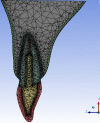Three-Dimensional Finite Element Study of Endodontically Treated Maxillary Central Incisors Restored Using Different Post and Crown Materials
- PMID: 36798627
- PMCID: PMC9925666
- DOI: 10.7759/cureus.33778
Three-Dimensional Finite Element Study of Endodontically Treated Maxillary Central Incisors Restored Using Different Post and Crown Materials
Abstract
Background/purpose: Restoring endodontically treated teeth is a common problem in dental practice. Post and core restorations are one of the major options in the rehabilitation of these teeth. However, there is no final decision regarding the best material or technique to be used with these restorations. So, this study aimed to evaluate the effect of different post and crown materials on the biomechanical behavior of restored maxillary central incisor using the finite element method.
Materials and methods: A total of 10 3D models of endodontically treated maxillary central incisors restored with two prefabricated posts and three custom-made posts were modeled and grouped according to post material (gold, nickel-chrome, zirconia, and glass fiber) and crown material (lithium disilicate, and zirconia). Finite element analysis was conducted, and stress distribution was evaluated using von Mises criteria.
Results: Both crown materials showed stress concentration at the force application site mainly on the intaglio palatal surface of the crown. However, more stress values were observed within zirconia crowns. All posts showed stress concentration at their buccal sides. However, more stress values were observed in zirconia and metal cast posts compared to glass fiber posts that transfer more stress to root dentin.
Conclusions: Post and crown materials affect the stress distribution in the tooth-restoration complex. Using high elastic modulus posts slightly decreased stress in root dentin despite concentrating more stress within their structure. However, glass fiber posts resulted in more homogenous stress distribution in the tooth-restoration complex. Crown material did not influence the stress distribution in root dentin. Custom-made posts decreased stress within crowns, regardless of the crown material. However, more stress values were observed within zirconia crowns. Custom-made zirconia posts and cores showed a similar stress distribution as non-precious metal cast posts, so they may be used as a suitable option where esthetic is desirable.
Keywords: 3d finite element method; cast metal post and core; computer-aided design and computer-aided manufacturing (cad/cam); glass fiber post; post and core; stress distribution; zirconia post.
Copyright © 2023, Kharboutly et al.
Conflict of interest statement
The authors have declared that no competing interests exist.
Figures





References
-
- Fracture resistance of teeth restored with post-retained restorations: an overview. Al-Omiri MK, Mahmoud AA, Rayyan MR, Abu-Hammad O. J Endod. 2010;36:1439–1449. - PubMed
-
- Effect of the crown, post, and remaining coronal dentin on the biomechanical behavior of endodontically treated maxillary central incisors. Veríssimo C, Simamoto Júnior PC, Soares CJ, Noritomi PY, Santos-Filho PC. J Prosthet Dent. 2014;111:234–246. - PubMed
LinkOut - more resources
Full Text Sources
Miscellaneous
